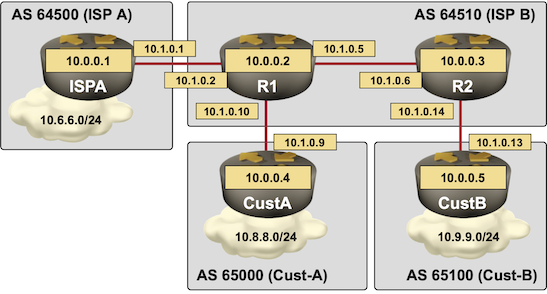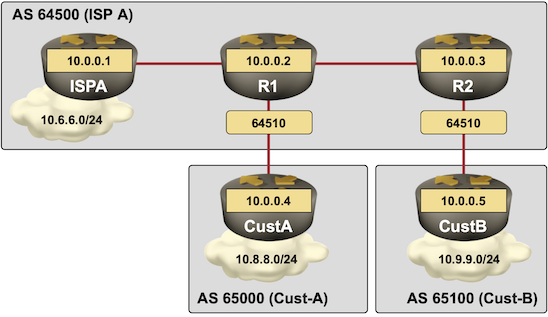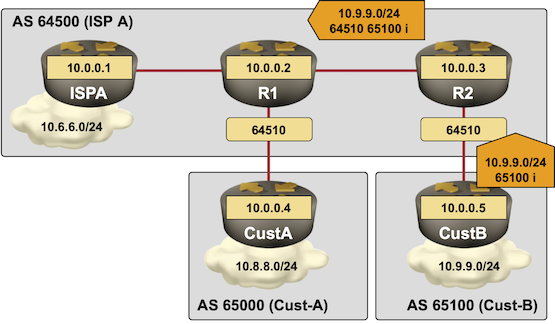… updated on Sunday, April 13, 2025 09:05 +0200
Network Migration with BGP Local-AS Feature
The Cisco IOS BGP Local-AS feature allows a BGP-speaking router to impersonate an autonomous system different from the one configured with the router bgp global configuration command. Its primary use facilitated seamless AS mergers; later additions made it applicable to AS renumbering scenarios. In the meantime, most other network operating systems implemented equivalent features (netlab can configure local AS functionality on over a dozen platforms)
The BGP Local-AS feature is usually configured with the neighbor IP-address local-as AS-number router configuration command. Subsequent IOS releases added the no-prepend keyword to clean up the AS path, as well as replace-as and dual-as keywords to support AS renumbering.
Typical Network Migration Usage Scenario
The BGP Local-AS functionality was designed to ease network migration in ISP merger/acquisition scenarios. For example, assume that ISP B (AS 64510) is merging with ISP A (AS 64500):

Testbed diagram and addressing
When the routers in AS 64510 are moved into AS 64500, the EBGP peering sessions with the customers must be reconfigured on the customer’s side, requiring significant coordination and planning efforts. The Local-AS feature allows the migrated PE routers to participate in AS 64500 while impersonating AS 64510 toward the customers’ CE routers:

R1 and R2 impersonate AS 64510 toward CE routers
The routers using the Local-AS feature retain the information that the BGP routes have passed the local AS in the AS path. They prepend local-AS in inbound EBGP updates and prepend both the actual AS number and the local-AS number in outbound EBGP updates.

AS-path processing in the migrated network
Sample Network Migration and Monitoring
The migration of our test network is performed in these steps:
- OSPF is established between ISPA, R1 and R2.
- The EBGP session between ISPA and R1 is changed into an IBGP session.
- Complete BGP configuration has to be removed and reconfigured on R1 and R2 (it’s impossible to change the BGP AS number once the BGP routing process has started).
- A new IBGP session structure must be established between old and new members of AS 64500. In the test network, R1 will be configured as a route reflector and ISPA and R2 as its clients, resulting in no extra IBGP sessions and minimal configuration changes. You can expect significantly more changes in an actual production network.
BGP Topology before Network Migration
The following printouts contain the state of the BGP routing tables (RIB) on all test network routers before the network migration. You can use these tables to compare the initial network state with the migration results.
ispa#show ip bgp | begin Network
Network Next Hop Metric LocPrf Weight Path
*> 10.6.6.0/24 0.0.0.0 0 32768 i
*> 10.8.8.0/24 10.1.0.2 0 64510 65000 i
*> 10.9.9.0/24 10.1.0.2 0 64510 65100 i
r1#show ip bgp | begin Network
Network Next Hop Metric LocPrf Weight Path
*> 10.6.6.0/24 10.1.0.1 0 0 64500 i
*> 10.8.8.0/24 10.1.0.9 0 0 65000 i
*>i 10.9.9.0/24 10.0.0.3 0 100 0 65100 i
r2#show ip bgp | begin Network
Network Next Hop Metric LocPrf Weight Path
*>i 10.6.6.0/24 10.0.0.2 0 100 0 64500 i
*>i 10.8.8.0/24 10.0.0.2 0 100 0 65000 i
*> 10.9.9.0/24 10.1.0.13 0 0 65100 i
custA#show ip bgp | begin Network
Network Next Hop Metric LocPrf Weight Path
*> 10.6.6.0/24 10.1.0.10 0 64510 64500 i
*> 10.8.8.0/24 0.0.0.0 0 32768 i
*> 10.9.9.0/24 10.1.0.10 0 64510 65100 i
custB#show ip bgp | begin Network
Network Next Hop Metric LocPrf Weight Path
*> 10.6.6.0/24 10.1.0.14 0 64510 64500 i
*> 10.8.8.0/24 10.1.0.14 0 64510 65000 i
*> 10.9.9.0/24 0.0.0.0 0 32768 i
Router Configuration Changes
We have to start the OSPF process on ISPA and run OSPF on the WAN link between ISPA and R1. Furthermore, the EBGP session between ISPA and R1 must be converted into an IBGP session established between the loopback interfaces of ISPA and R1:
interface Ethernet0/1
description ispa -> r1
ip ospf network point-to-point
ip ospf 1 area 0.0.0.0
!
router ospf 1
router-id 10.0.0.1
!
router bgp 64500
no neighbor 10.1.0.2
neighbor 10.0.0.2 remote-as 64500
neighbor 10.0.0.2 description r1
neighbor 10.0.0.2 update-source Loopback0
!
address-family ipv4
neighbor 10.0.0.2 activate
neighbor 10.0.0.2 next-hop-self
exit-address-family
More extensive changes are needed on R2: the whole BGP configuration has to be removed, and a new BGP process with a different AS number has to be started. Local AS is configured on customer EBGP sessions to avoid configuration changes on the customer’s end.
no router bgp 64510
!
router bgp 64500
bgp router-id 10.0.0.3
neighbor 10.0.0.2 remote-as 64500
neighbor 10.0.0.2 description r1
neighbor 10.0.0.2 update-source Loopback0
neighbor 10.1.0.13 remote-as 65100
neighbor 10.1.0.13 local-as 64510
neighbor 10.1.0.13 description custb
R1 requires changes in OSPF and BGP configuration. OSPF has to be enabled on the WAN link between R1 and ISPA. The EBGP configuration has to be reentered with a different AS number. Customer EBGP sessions need a local AS number, and the IBGP sessions are configured as route reflector server-to-client sessions.
interface Ethernet0/1
description r1 -> ispa
ip ospf network point-to-point
ip ospf 1 area 0.0.0.0
!
no router bgp 64510
!
router bgp 64500
neighbor 10.0.0.1 remote-as 64500
neighbor 10.0.0.1 description ispa
neighbor 10.0.0.1 update-source Loopback0
neighbor 10.0.0.1 route-reflector-client
neighbor 10.0.0.1 next-hop-self
!
neighbor 10.0.0.3 remote-as 64500
neighbor 10.0.0.3 description r2
neighbor 10.0.0.3 update-source Loopback0
neighbor 10.0.0.3 route-reflector-client
neighbor 10.0.0.3 next-hop-self
!
neighbor 10.1.0.9 remote-as 65000
neighbor 10.1.0.9 local-as 64510
neighbor 10.1.0.9 description custa
No configuration changes are needed on the customers’ CE routers.
BGP Topology after the Network Migration
BGP tables on ISPA are the least affected by the network migration. The only noticeable change is a different next-hop for routes received from CustB via R2. Previously, the next-hop was changed by the EBGP session between ISPA and R1; now, it’s propagated unchanged across AS 64500. The AS paths for IP prefixes received from the customers are also unchanged: they look like they would still pass through AS 64510 due to inbound prepending of the BGP Local AS.
ispa#show ip bgp | begin Network
Network Next Hop Metric LocPrf Weight Path
*> 10.6.6.0/24 0.0.0.0 0 32768 i
*>i 10.8.8.0/24 10.0.0.2 0 100 0 64510 65000 i
*>i 10.9.9.0/24 10.0.0.3 0 100 0 64510 65100 i
The changes on R1 and R2 are also minor – as they belong to the same AS as ISPA, the IP prefix advertised by ISPA has become an internal BGP route with an empty AS path:
r1#show ip bgp | begin Network
Network Next Hop Metric LocPrf Weight Path
*>i 10.6.6.0/24 10.0.0.1 0 100 0 i
*> 10.8.8.0/24 10.1.0.9 0 0 64510 65000 i
*>i 10.9.9.0/24 10.0.0.3 0 100 0 64510 65100 i
r2#show ip bgp | begin Network
Network Next Hop Metric LocPrf Weight Path
*>i 10.6.6.0/24 10.0.0.1 0 100 0 i
*>i 10.8.8.0/24 10.0.0.2 0 100 0 64510 65000 i
*> 10.9.9.0/24 10.1.0.13 0 0 64510 65100 i
The migration effects on the customer routers are more dramatic. The AS paths of prefixes originated in AS 64500 (and any network beyond AS 64500) are unchanged, but the paths to other customers of ISPB have changed significantly. Before the migration, the path between CustA and CustB passed only through AS 64510. Now, it looks like it passes through two copies of AS 64510 (due to inbound and outbound prepending of Local AS) as well as through the AS 64500 (the actual AS of ISPA).
custa#show ip bgp | begin Network
Network Next Hop Metric LocPrf Weight Path
*> 10.6.6.0/24 10.1.0.10 0 64510 64500 i
*> 10.8.8.0/24 0.0.0.0 0 32768 i
*> 10.9.9.0/24 10.1.0.10 0 64510 64500 64510 65100 i
custb#show ip bgp | begin Network
Network Next Hop Metric LocPrf Weight Path
*> 10.6.6.0/24 10.1.0.14 0 64510 64500 i
*> 10.8.8.0/24 10.1.0.14 0 64510 64500 64510 65000 i
*> 10.9.9.0/24 0.0.0.0 0 32768 i
Revision History
- 2025-04-13
- Migrated an archived copy of a long-gone article to ipSpace.net blog
- Created a corresponding netlab topology to help readers reproduce the scenario
- Printouts were recreated on Cisco IOS XE devices.

So I went conf t, router bgp, bgp enforce, show ip bgp, hmm, still here, this should be the time for me to test out another command - soft-configuration inbound, followed by clear ip bgp x.x.x.x soft in, hmm, the BGP route is still here, clear ip bgp x.x.x.x, aargghhh, still there. >:o
show run, hey, where is my "bgp enforce-first-as" command? What? It is enabled by default? @_@
After some thought, another ASN (the local AS) actually being prepended to the AS_SEQUENCE by the local router, the EBGP peer doing its job correctly therefore not being discarded by the "bgp enforce-first-as" command.
I think I will only able to see the operation of the "bgp enforce-first-as" when reading more about BGP route spoofing attacks in the future, now it is good enough for my ROUTE exam. :)